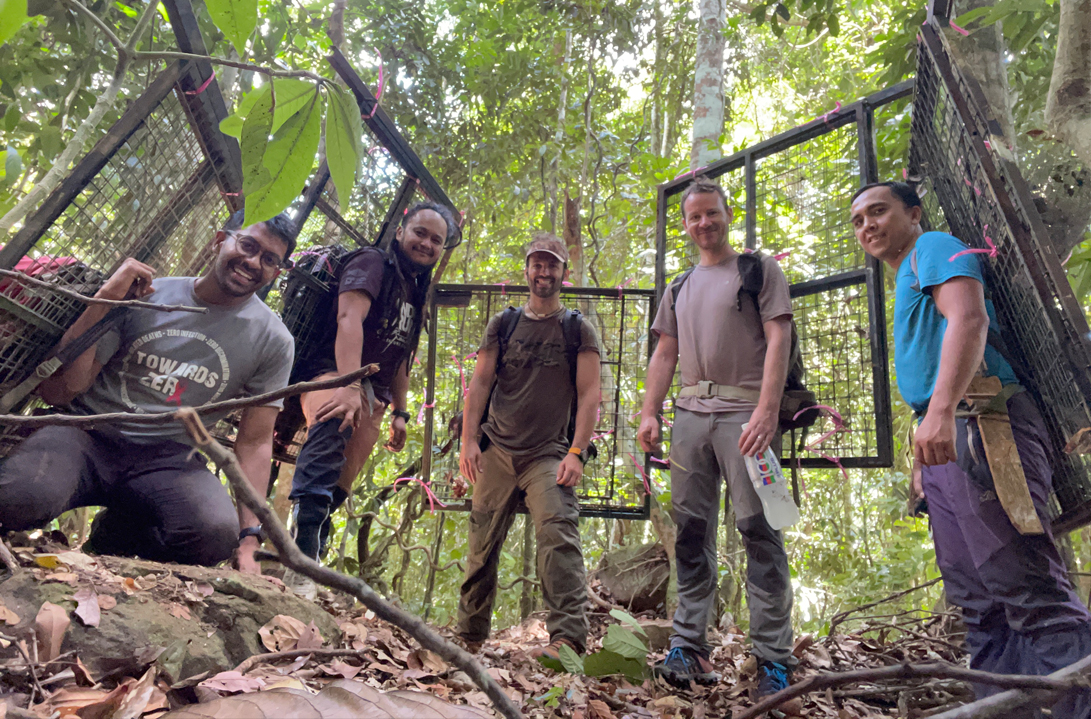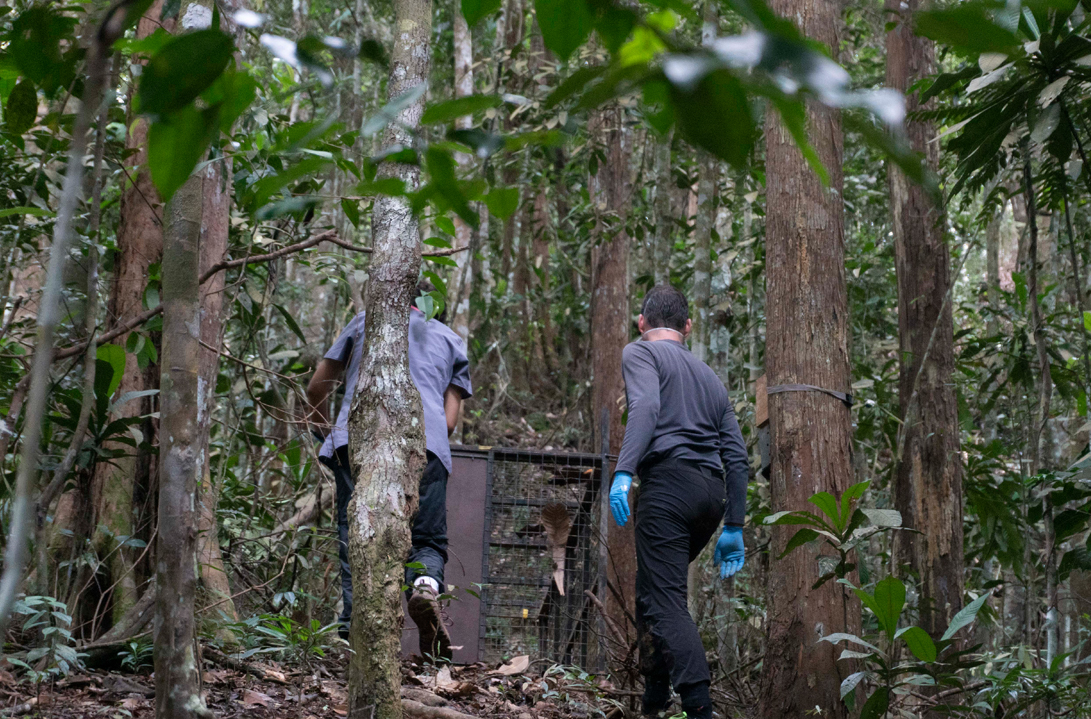The Bornean Carnivore Programme (BCP) has been studying Borneo’s elusive carnivores since 2005. Starting with camera trapping in Sabah to research the Sunda clouded leopard (Neofelis diardi), the BCP has developed key tools for understanding population dynamics and landscape connectivity using advanced modelling. In collaboration with local partners, the programme translates long-term research into policies guiding conservation and sustainable land use.
CONSERVATION CONTEXT
Borneo is a treasure chest of biodiversity. With some of the highest rates of endemism and species richness, Borneo’s wealth of resources have fuelled rapid economic growth. Four decades of intensive land-use changes on Borneo have led to some of the highest rates of biodiversity loss on the planet. The patchy distributions of remaining forest on Borneo have severely fragmented habitats, plunging many wild populations into an extinction vortex.
Our research on Bornean carnivores has allowed us to map both where populations exist today but also how connected these populations are. Sunda clouded leopards (Neofelis diardi) are an excellent study species for studying connectivity, as they exist in low densities, and are heavily impacted by habitat fragmentation. Since 2014, we began actively collaring and sequencing genomes of these elusive predators to develop robust connectivity models. These models are being used to inform land-use managers on crucial sites for connectivity and habitat restoration.
Targeted connectivity restoration will have the dual benefit of securing a long-term refuge for biodiversity, but also crucially, facilitate species range shifts in response to climate change. WildCRU researchers have been leading the development of methods for modelling habitat suitability and connectivity of a broad range of mammals on Borneo since beginning a field operation in Sabah, in 2005. In that time, numerous workshops have been held to communicate the evidence for connectivity loss. As a direct result, in early 2024 connectivity restoration and ecological corridors were listed in the Sabah Biodiversity Strategy 2034 – a ten year biodiversity plan developed by the Sabah Biodiversity Centre (SaBC) to steer Sabah’s intensive development plans over the next few decades.


APPROACH
Fifteen years of high-resolution data on Sunda clouded leopards allowed us to test cutting-edge models and develop connectivity prediction approaches that can be used by land-use managers. Over time, we have fine-tuned our ability to draw mathematical relationships between environmental variables and the movement or dispersal of these animals on Borneo. While focusing on Sunda clouded leopards, these methods have already triggered a flurry of research and modelling for other species on Borneo with sufficient data.
In 2018, we began the development of CoLa (Connecting Landscapes), a wildlife connectivity modelling toolkit trained on Southeast Asian datasets. Set for release in late 2024 as an open-source platform in partnership with NASA, CoLa has garnered interest. A demonstration workshop in July 2024 led to SaBC inviting WildCRU to consult with state land-use agencies on integrating CoLa into ecological assessments. This meeting underscored the need for tools that leverage Sabah’s extensive biodiversity data.
PROGRAMME IMPACT HIGHLIGHTS
Co-authored Sabah clouded leopard action plan 2016-2024
Co-developed CoLa (Connecting landscapes) application in collaboration with NASA and Northern Arizona University.
Conducted CoLa workshops for senior government officials, NGOs and research institutions in Sabah, July 2024
Invited to facilitate CoLa workshop for land-use planners in Sabah on behalf of Sabah Biodiversity Centre
PROGRAMME MEMBERS
Dr. Andrew Hearn is founder and Director of the Bornean Carnivore Programme. Chrishen Gomez is researcher and PhD candidate after beginning as full-time field manager of the BCP in 2018.
KEY PUBLICATIONS
Projected development in Borneo and Sumatra will greatly reduce connectivity for an apex carnivore
Multi‐scale, multivariate community models improve designation of biodiversity hotspots in the Sunda Islands
Diet and prey selection of clouded leopards and tigers in Laos
Projected development in Borneo and Sumatra will greatly reduce connectivity for an apex carnivore
The islands of Borneo and Sumatra are strongholds for biodiversity and home for many endemic species. They also have experienced amongst the highest deforestation rates globally. Both islands are undergoing massive, rapid infrastructure development, leading to further deforestation and habitat fragmentation. Here, we identify priority areas for continued functional forest connectivity across Borneo and Sumatra, using spatial models of clouded leopard (Neofelis diardi, a forest indicator species) movement, and impacts thereto from existing and future infrastructure development. We specifically measure and map the anticipated impacts on forest functional connectivity of three major infrastructure development projects (Pan Borneo Highway, Trans-Sumatran Toll Road, and the new Indonesian capital city of Nusantara). We found that core clouded leopard habitats are already highly fragmented in Sumatra, constituting only ∼13 % of the island, with potential dispersal corridors still linking some habitat fragments. In Borneo, clouded leopard core habitats cover 34 % of the island, with one large central core area and several much smaller satellite cores, which are largely unprotected (15 % protected, compared to 42 % in Sumatra). The largest negative effect on habitat connectivity was predicted for Nusantara (66 % of the total connectivity loss predicted for all three infrastructure projects), reverberating across the entirety of Borneo with the strongest effects in East Kalimantan. The Pan Borneo Highway accounted for 28 % of the total connectivity loss, affecting every province in Borneo and Brunei, with 6 % of this decrease located within protected areas. The Trans-Sumatran Toll Road had the smallest negative effect on connectivity (6 %) but only when excluding the already built segments, which, when included, produce a total negative impact similar to that of the Pan Borneo Highway.
Multi‐scale, multivariate community models improve designation of biodiversity hotspots in the Sunda Islands
Species occur in sympatric assemblages, bound together by ecological relationships and interspecific interactions. Borneo and Sumatra host some of the richest assemblages of biota worldwide. The region, however, faces the highest global deforestation rates, which seriously threaten its unique biodiversity. We used a large camera trap dataset that recorded data for 70 terrestrial species of mammals and birds, to explore the drivers of regional species richness patterns. Using a multi-scale, multivariate modelling framework which quantified the main environmental factors associated with patterns of biodiversity, while simultaneously assessing individual relationships of each species, we determined the ecological drivers of sampled biodiversity, and their contributions to community assemblages. We then mapped predicted species richness, evaluated the effectiveness of protected areas in securing biodiversity hotspots, performed gap analysis to highlight biodiverse areas lacking protection and compared our predictions with species richness maps produced by using IUCN range layers. Finally, we investigated the performance of each species as an indicator of sampled biodiversity. We demonstrate that biodiversity in Borneo and Sumatra is primarily affected by gradients of ecological and anthropogenic factors, and only marginally by topographic and spatial factors. In both islands, species are primarily associated with elevational gradients in vegetation and climate, leading to altitudinal zonation in niche separation as a major factor characterizing the islands’ biodiversity. Species richness was highest in north-eastern Borneo and in western Sumatra. We found that most predicted biodiversity hotspots are not formally protected in either island; only 9.2 and 18.2% of the modelled species richness occurred within protected areas in Borneo and Sumatra, respectively. We highlighted that our prediction for Borneo performed better than, and differed drastically from, the IUCN species richness layer, while for Sumatra our modelled species richness layer and the IUCN one were similar, and both showed low predictive power. Our analysis suggests that common and generalist carnivores are the most effective indicators of sampled biodiversity and have high potential as focal, umbrella or indicator species to assist multi-species vertebrate conservation planning. Understanding existing drivers and patterns of biodiversity is critical to support the development of effective community conservation strategies in this rapidly changing region.
Diet and prey selection of clouded leopards and tigers in Laos
In Southeast Asia, conservation of ‘Vulnerable’ clouded leopards (Neofelis nebulosa) and ‘Endangered’ tigers (Panthera tigris) might depend on the management of their preferred prey because large felid populations are limited by the availability of suitable prey. However, the diet of clouded leopards has never been determined, so the preferred prey of this felid remains unknown. The diet of tigers in the region has been studied only from one protected-area complex in western Thailand, but prey preferences were not determined. To better understand the primary and preferred prey of threatened felids, we used DNA-confirmed scats and prey surveys to determine the diet and prey selection of clouded leopards and tigers in a hilly evergreen forest in northern Laos. For clouded leopards, the primary prey was wild pig (Sus scrofa; 33% biomass consumed), followed by greater hog badger (Arctonyx collaris; 28%), small rodents (15%), and mainland serow (Capricornis sumatraensis; 13%; hereafter, serow). For tigers, the primary prey was wild pig (44%), followed by serow (18%), sambar (Rusa unicolor; 12%), and Asiatic black bear (Ursus thibetanus; 10%). Compared to availability, serow was positively selected by both clouded leopards (D = 0.69) and tigers (0.61), whereas all other ungulate species were consumed in proportion to the availability or avoided. Our results indicate that clouded leopards are generalist predators with a wide prey spectrum. Nonetheless, mid-sized ungulates (50–150 kg) comprised nearly half of their diet, and were the preferred prey, supporting a previous hypothesis that the enlarged gape and elongated canines of clouded leopards are adaptations for killing large prey. Because serow was the only ungulate preferred by both felids, we recommend that serow populations be monitored and managed to help conservation efforts for clouded leopards and tigers, at least in hilly evergreen forests of Southeast Asia.